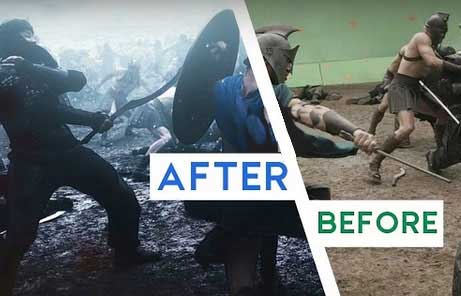
.”What’s the difference between storyboarding, pre-vis and post-vis? Which tools can help streamline the process of film production?” Filmmakers ask our team members this question all the time. So here are some answers from our experience as well as from some of our clients.
Let’s start at the end…
Post-vis, is similar to pre-vis, but done after principle photography (during editing). Post-vis is especially helpful when working on VFX heavy projects. Until rendering is finalized (i.e. CG characters, compositing FX), editors layer elements over edited footage as place holders. Editors create rough cuts by laying in blank slugs.* Then second unit footage and pickup shot are added. This is where post-vis and pre-vis can meet. Directors, VFX** supervisors and VFX producers may pre-vis FX scenes before they shoot or render to check for timing in a rough cut.
*Previously, editors used blank-black leader/footage to substitute for missing sequences (or text over black) in order to approximate the timing of the project. Now they can use Martini QuickShot Creator Post-Vis Plug-in to get a better visual and timing feel for what’s missing in their rough cuts.
**Visual Effects (VFX) are done in post-production. Special Effects are carried out on set during production.
…and work back…
Pre-vis and storyboards are created before editing and prior to principal photography. (We’re working backwards, remember?)
The term “Pre-vis” is used for detailed storyboards. This includes mocking up shots/sequences (i.e. compositing temp elements with existing footage) or creating animatics. The art department and/or 3D modelers work from the animatic to complete the final product or rendering.
…to the beginning.
In the beginning …there are storyboards. Director, writers, producers use storyboards or concept boards to plan projects. Storyboard are also use to work out story ideas, plan camera setups and communicate with crew. Production time and equipment can be expensive. Visual planning expedites set-up time and increases the ability to make successful projects. Just as you imagined. There’s just no substitute for a good plan.
Storyboards can help pitch/sell ideas to producers and/or potential clients in advertising, filmmaking and animation. Storyboards help the client see concepts and shows organizational skills and storytelling abilities.
Director, Roger Christiansen, shared the following anecdote from his experience while directing a Disney project. After a complicated last minute sequence change: “I opened my laptop, fired up my StoryBoard Quick and in a few seconds we were all on the same page for the next series of shots.”
So whether directing on set, creating production plans or have filmed the last shot-the “Martini Shot”- PowerProduction’s storyboard software will assist your visualization. For projects of all budget levels -whether in 2D or 3D. Ideas are fragile, so when beginning, handle with care!
Storyboarding or concept boards: StoryBoard Quick, StoryBoard Quick Studio.
Pre-vis: StoryBoard Artist, and StoryBoard Artist Studio.
For post-vis: Martini QuickShot Creator has a Macintosh and Windows version for directors, editors, special effects supervisors. Plug-in to Final Cut Pro, Avid Media Composer, Premiere Pro (Mac) and Premiere Pro and Sony Vegas (Windows).
Visit our site and check out your options.

